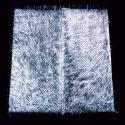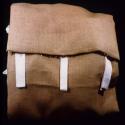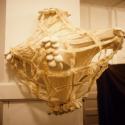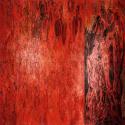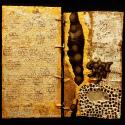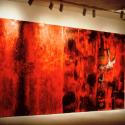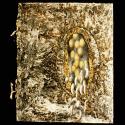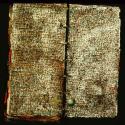Kim, Heejung
Other Names: 김희정
Artist Website
"I have been making art on the basis of the idea [that] came from my imagination and eastern philosophies, especially Buddhism. I have been studying Buddhism and I realized that some central ideas of Buddhism support my understanding of life and making art. I intensively studied Mandala paintings in Tibet. Mandala means the map of universe. Its structure has been delineated in numerous Buddhist sutras. The sutras explain [the] fantastic world of universe: macrocosm and microcosm contain same structure, sesame seed sized Buddhas and bodhisattvas fill in all the space, and so on. The subjects of my art works are stories told in Buddhism in conjunction with my kaleidoscope inner world. My inner world is related to my Karma that is described by the images dealing with emotions from personal memories, intuition, and imagination.
The process of making art is involved with repetition of same movement. Like monks meditate upon Emptiness, [sitting on the] same spot and facing the wall for days, months, or years, I repeat same movement, mostly sewing, for hours and hours in order to complete works of art. While doing so, my mind becomes Empty losing track of time, and eventually repetition of same movement is transfigured as one [method] for meditation.
My works of art create an intimate relationship with the viewer. Whether they are in the form of handmade books or wrapped sculptures, [interaction] between the art works and the viewer always occurs in order to view the entire works of art. When the viewer turns the pages of handmade books, for instance, he/she would feel [as if he/she were listening] to a secret story because he/she doesn’t look at all pages simultaneously but rather, sequentially. In order to view the wrapped sculptures, the viewer needs to untie straps to open up the cover. The process of exhibiting the art works is related to the way people understand the world. Small segments are accomplished in our minds at the end whether it is physically visible or imaginative. I, as an artist, also interact with my art works while creating them. I make the structure of my wrapped pieces, but the final form is the result of relationship between the [support], cloth, and the path of threads. It is accomplished by natural force due to the tension between two or three materials.
The final form of an artwork is determined by gravity. Human beings are powerful on earth, but we don’t exist by ourselves, but with nature."
Heejung Kim, Artist Statement, 2003
Gallery of Selected Works
Selected Documents
- Article "Boundary: Liberty and Equality on Everybody's Face" by Heejung Kim in New Observations, winter 1998
- Article "Curator Women" in Korea Times New York, January 29, 2003
- Article "In Their Sights" by Laurel Berger in ARTnews, March 1997
- Article in The Segye Times, January 30, 1998
- Artist Resume, [1996]
- Artist Statement(s)
- Excerpts from exhibition brochure for "text & identity: twelve women/twelve artists", Staller Center for the Arts, State University of New York at Stony Brook, 1997
- Exhibition postcard for "The World Between: Sculptural Books by Heejung Kim", New Jersey City University, 2007
- Exhibition press release for "Our Deities", Ise Art Foundatin, 1996
- Exhibition flyer and poster for "The AAAC Story", Asian American Arts Centre, 2002
- Exhibition flyer for "Passion & Compassion: Five Artists Reflections on Buddhism", Asian American Arts Centre, 1996
- Exhibition press release for "Passion & Compassion: Five Artists Reflections on Buddhism", Asian American Arts Centre, 1996
- Exhibition press release for "The AAAC Story", Asian American Arts Centre, 2002
Other Links
View artist folder list at Asian American Arts Centre

